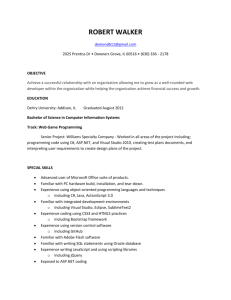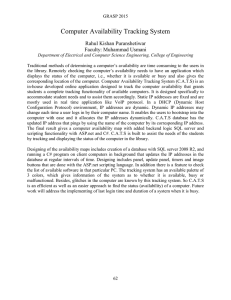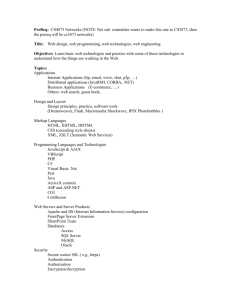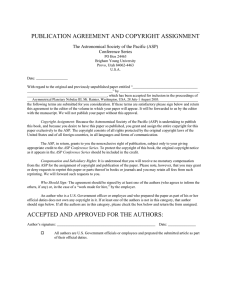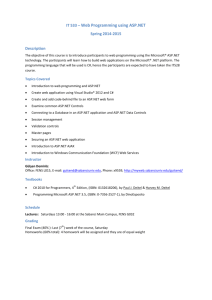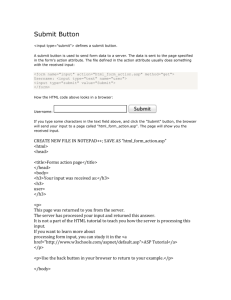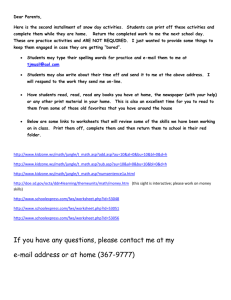Chapters 15 - Web Application Development
advertisement
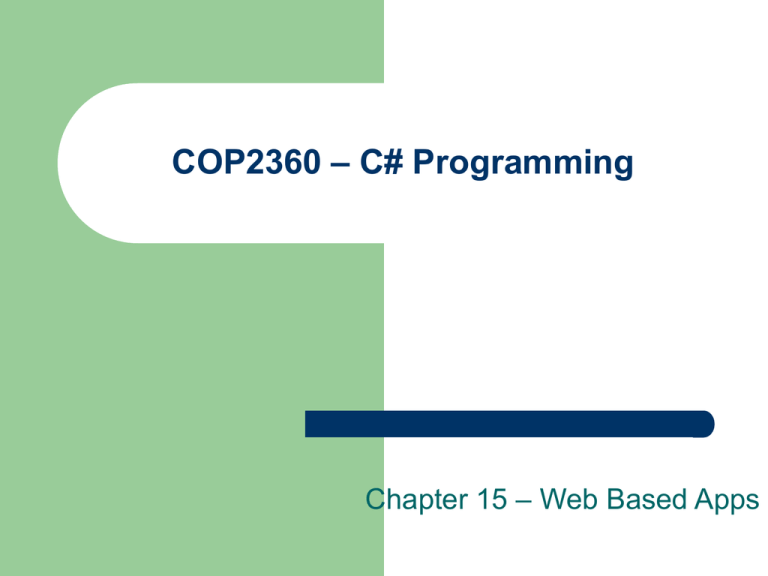
COP2360 – C# Programming Chapter 15 – Web Based Apps Announcements Assignment 5 will be a Class Project – – – We will be developing a basic registration and transcript system based on the database we looked at last week. We will work together in developing this, but everyone must have their own system (and can make changes so that it looks like they want it to look.) We’ll start on the project next class. Web Based Application Development Uses a Client/Server approach to applications – – The Client for Web Based Applications is a Web Browser running in a person’s PC The Server is a centrally located computer that receives requests from the client and sends page information to be displayed on the browser. Web Based Application Development Is based on several standards that have grown over the years – HTML – Hyper Text Mark-Up Language – CSS – Cascading Style Sheets – A configuration file that helps ensure consistency in a web application by defining fonts/colors and other attributes to be then applied in the HTML Server Side Scripting Languages – Not a true programming language – Instead it is the way the server tells the client what to display within a web page PHP (Used to be Personal Home Page – now PHP Hypertext Preprocessor (Notice the recursion)) ASP – Active Server Pages ASP.Net – Latest version using Dot Net Framework Client Side Scripting Languages javaScript Web Based Application Development This structure is very different from the WebForm applications we have been playing with – – With a WebForm, the application is actively running on the person’s PC, and can react to any of the events we have looked at for each control With a Web Application, although there can be some client side processes that can react to some events, most interaction is done by a “submission” to the server, and the a “post back” to the client. Static vs Dynamic Pages Web Pages are usually lumped into two types: – – Static web pages are those pages that don’t change. They are usually for showing the same information over and over again Dynamic Web Pages are pages that do change based on what the user selects from an original page. They usually involve some type of data store that is included in the send of information to the client. Our Stinky Little Web Site Let’s Take A Look Let’s Look what happened when we type in the URL (Uniform Resource Located…That http:// thing) Comment on Browsers A pretty picture of Dynamic Web Site in Operation How Is Visual Studio Involved Visual Studio allows one to develop Web Applications that can be published to a web server It let’s a programmer develop in either pure HTML or ASP.Net or a combination of the two. Remember, the code being created is running on a Server, and sending back the information in HTML format to the client (even if both the client and server are on the same PC). Let’s Make Our First Web Page Basic Static Web Page using VS 2012 – – Start VS201 Select New Project – ASP.NET Empty Web Application Call it Chapter15 Right Click on Project in Solution Explorer Select New -> Web Page ->Name it Simple Let’s Look at the HTML Code that was generated Let’s Make a Simple Dynamic Web Page Revisit our BMI calculator Let’s Look at the code that is generated – And at the HTML that is returned Let’s Go Through Similar Controls We Learned in WINForms – Check Boxes, DropDownLists, Radio Buttons Look at the neat lists for Check Boxes and Radio Buttons In Class Assignment Develop a Web Page that will calculate the monthly mortgage payment after the user enters the mortgage amount, number of year and interest rate. – – M = P [ i(1 + i)^n ] / [ (1 + i)^(n) – 1)] Where M is the monthly payment. i = r/12. The same formula can be expressed many different way, but this one avoids using negative exponentials which confuse some calculators. (http://www.fonerbooks.com/interest.htm) Add a Check Box List so that the calculation is Weekly, Month or Yearly Add AutoPostBack to the Check Box List, so the calculation changes without pressing the command button. Make it pretty!! Publish what you have done to your Web Site. Web Pages and Connecting To A Database Can do the connection three ways – – – Using the OLEDB commands we went over last week Placing all the Database Commands into a Web Server and accessing the server Using ASP Data Source Controls Let’s play with this way Fairly straight forward (more so than Web Forms)
